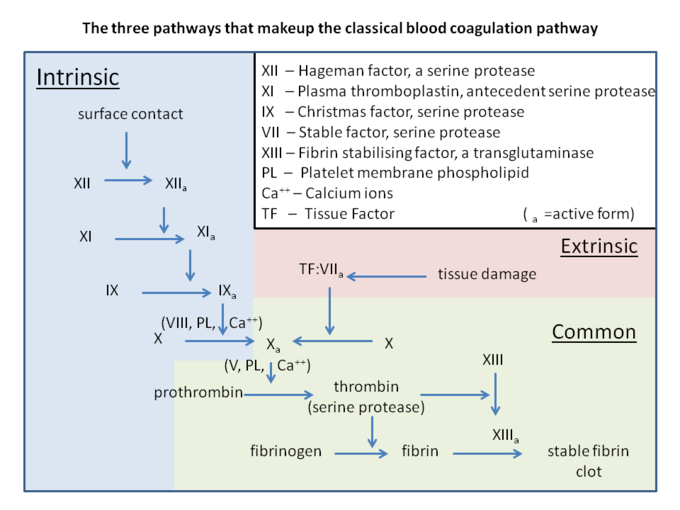Sandbox GGC6
From Proteopedia
(Difference between revisions)
| Line 33: | Line 33: | ||
This process called coagulation cascade (or secondary hemostasis) forming a stable insoluble fibrin clot. The process has two pathways which are intrinsic and extrinsic pathway. These pathways eventually join to become the common pathway. | This process called coagulation cascade (or secondary hemostasis) forming a stable insoluble fibrin clot. The process has two pathways which are intrinsic and extrinsic pathway. These pathways eventually join to become the common pathway. | ||
| - | - Intrinsic pathway: This begins with activated factor XII, which then activates factor XI. Activated factor XI further activates factor IX, which activates factor VIII to form tenase complex on a phospholipid surface to activate factor X in the common pathway. <ref>PMID: 25535411</ref> | ||
| - | - Extrinsic pathway: when a tissue is damaged, it releases tissue factor to activate factor VII, which then activates factor X. | ||
| - | - Common pathway: either intrinsic pathway or extrinsic pathway activates factor X causes formation of thrombin from prothrombin. Thrombin will cleave fibrinogen to insoluble fibrin and also activate factor XIII. Factor XIII and fibrin bind together forming a stable bond and attach to platelets. | ||
| + | ''- Intrinsic pathway:'' This begins with activated factor XII, which then activates factor XI. Activated factor XI further activates factor IX, which activates factor VIII to form tenase complex on a phospholipid surface to activate factor X in the common pathway. | ||
| + | ''- Extrinsic pathway:'' when a tissue is damaged, it releases tissue factor to activate factor VII, which then activates factor X. | ||
| + | '' | ||
| + | - Common pathway:'' either intrinsic pathway or extrinsic pathway activates factor X causes formation of thrombin from prothrombin. Thrombin will cleave fibrinogen to insoluble fibrin and also activate factor XIII. Factor XIII and fibrin bind together forming a stable bond and attach to platelets. <ref>PMID: 25535411</ref> | ||
| + | |||
| + | == '''Structural highlights''' == | ||
This is a sample scene created with SAT to <scene name="/12/3456/Sample/1">color</scene> by Group, and another to make <scene name="/12/3456/Sample/2">a transparent representation</scene> of the protein. You can make your own scenes on SAT starting from scratch or loading and editing one of these sample scenes. <scene name='78/781192/Hydrophobic_and_polar/2'>this shows polar and unpolar structure of 1XKT </scene> | This is a sample scene created with SAT to <scene name="/12/3456/Sample/1">color</scene> by Group, and another to make <scene name="/12/3456/Sample/2">a transparent representation</scene> of the protein. You can make your own scenes on SAT starting from scratch or loading and editing one of these sample scenes. <scene name='78/781192/Hydrophobic_and_polar/2'>this shows polar and unpolar structure of 1XKT </scene> | ||
Revision as of 23:48, 15 November 2020
==Fibrinogen alpha chain==
| |||||||||||
References
- ↑ Hanson, R. M., Prilusky, J., Renjian, Z., Nakane, T. and Sussman, J. L. (2013), JSmol and the Next-Generation Web-Based Representation of 3D Molecular Structure as Applied to Proteopedia. Isr. J. Chem., 53:207-216. doi:http://dx.doi.org/10.1002/ijch.201300024
- ↑ Herraez A. Biomolecules in the computer: Jmol to the rescue. Biochem Mol Biol Educ. 2006 Jul;34(4):255-61. doi: 10.1002/bmb.2006.494034042644. PMID:21638687 doi:10.1002/bmb.2006.494034042644
- ↑ Iwaki T, Castellino FJ. Maternal fibrinogen is necessary for embryonic development. Curr Drug Targets. 2005 Aug;6(5):535-9. doi: 10.2174/1389450054546006. PMID:16026273 doi:http://dx.doi.org/10.2174/1389450054546006
- ↑ Asselta R, Plate M, Robusto M, Borhany M, Guella I, Solda G, Afrasiabi A, Menegatti M, Shamsi T, Peyvandi F, Duga S. Clinical and molecular characterisation of 21 patients affected by quantitative fibrinogen deficiency. Thromb Haemost. 2015 Mar;113(3):567-76. doi: 10.1160/TH14-07-0629. Epub 2014 Nov , 27. PMID:25427968 doi:http://dx.doi.org/10.1160/TH14-07-0629
- ↑ de Moerloose P, Neerman-Arbez M. Congenital fibrinogen disorders. Semin Thromb Hemost. 2009 Jun;35(4):356-66. doi: 10.1055/s-0029-1225758. Epub, 2009 Jul 13. PMID:19598064 doi:http://dx.doi.org/10.1055/s-0029-1225758
- ↑ Baker KR, Rice L. The amyloidoses: clinical features, diagnosis and treatment. Methodist Debakey Cardiovasc J. 2012 Jul-Sep;8(3):3-7. doi: 10.14797/mdcj-8-3-3. PMID:23227278 doi:http://dx.doi.org/10.14797/mdcj-8-3-3
- ↑ Benson MD, Liepnieks J, Uemichi T, Wheeler G, Correa R. Hereditary renal amyloidosis associated with a mutant fibrinogen alpha-chain. Nat Genet. 1993 Mar;3(3):252-5. PMID:8097946 doi:http://dx.doi.org/10.1038/ng0393-252
- ↑ Casini A, Blondon M, Lebreton A, Koegel J, Tintillier V, de Maistre E, Gautier P, Biron C, Neerman-Arbez M, de Moerloose P. Natural history of patients with congenital dysfibrinogenemia. Blood. 2015 Jan 15;125(3):553-61. doi: 10.1182/blood-2014-06-582866. Epub 2014, Oct 15. PMID:25320241 doi:http://dx.doi.org/10.1182/blood-2014-06-582866
- ↑ Palta S, Saroa R, Palta A. Overview of the coagulation system. Indian J Anaesth. 2014 Sep;58(5):515-23. doi: 10.4103/0019-5049.144643. PMID:25535411 doi:http://dx.doi.org/10.4103/0019-5049.144643

